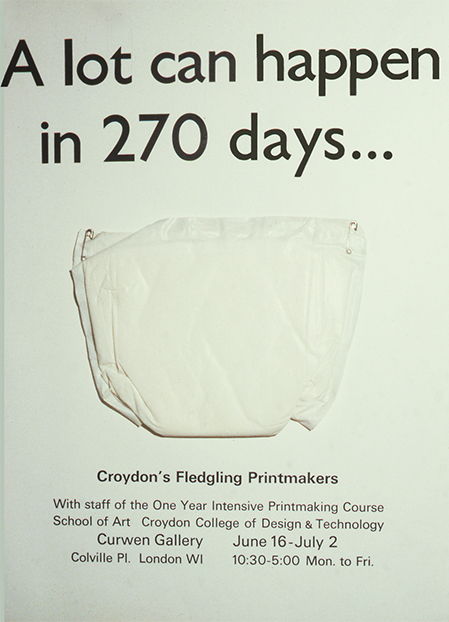David Stairs

The only good use I’ve ever found for disposable diapers, a 1976 poster. (Note the pins I added. Talk about double-entendre!)
I know I’m supposed to say that prize-winning financially successful ideas are examples of great design, and I wish it was always true but……. let’s get real. In the commercial world we’ve created, there are too many cases that contradict optimism. Take diapers, for instance.
Children have been wrapped in “swaddling cloth” since before the time of Christ, and those who have had the pleasure of parenthood understand that this entails no small measure of slimyness before their kid gains some bowel control. In fact, one of the earliest traumas a child must endure after weaning is the socialization of toilet training. But control can be years in the making. Meanwhile, somebody has to do the honors.
In an attempt to alleviate the stress on Mom, home delivered diaper services arose in the 1940s. Typical of an American obsession with cleanliness, the convenience of throwing soiled cloths in a pail and exchanging them for a stack of fresh, soft, clean white replacements must’ve seemed like a dream come true to young mothers in the ’50s. Diaper service was often included among the baby shower gifts before the days of carseat-stroller combos. But not everyone could afford such service, which put many Moms right back in laundry business.
American ingenuity to the rescue! In 1946 Marion Donovan first conceived of the disposable diaper. Pampers, the first commercial disposable was introduced in 1961 by Procter and Gamble. These were a little bulky compared to today’s version. As new materials were introduced and the market segmented the diapers slimmed, and broke down into size variants designed to grow with your baby. In 1978 Kimberly-Clark introduced Huggies, a fitted super-absorbent competitor to Pampers.
So, you’re probably thinking “I love disposable diapers and couldn’t imagine life without them.” I mean, what could be wrong with a diaper you don’t have to wash that can just be discarded, right? And so today 95% of American babies use disposables, and they create 2% of municipal solid waste. Not to mention that, since P&G nets $10 billion annually from the 28 million disposables used every year in America, they add hundreds of dollars to the average household budget.
It was about the time Pampers were introduced sixty years ago that we started to go off the tracks where convenience obsession is concerned. Manufacturers then looking for cheaper ways to bottle beverages began experimenting with one-way containers. I still lament the passing of refillable soda and beer bottles, which not only eliminated any need for bottle deposits, but also took a load out of our landfills. A little wear along the shoulder of one’s Coke bottle seems a small price to pay to prevent the catastrophe of plastic waste we’ve inherited.
Which is also the problem with disposable diapers, so much so that P&G offers a “system” called Pampers Pure Hybrid— a cloth diaper with a disposable insert. Don’t think major corporations don’t listen to customer complaints, after they have already hooked you to their system, kinda like your cable and internet provider.
Full disclosure: none of my children used disposable diapers (and all of them were born at home), but I’m weird like that. So far as I can see, re-washable cloth diapers and plastic pants work just fine for the first two years of life, putting no additional strain on the environment. I didn’t have a problem rinsing them out before washing, and my kids never got terminal diaper rash.
As for the design awards for those inevitably brilliant convenience products, well, I’ve done just fine all these years without having to squeeze the Charmin’.
Ooops, that’s a dumb design ’60s mixed metaphor. Sorry Mr. Whipple!
David Stairs is the founding editor of the Design-Altruism-Project.










